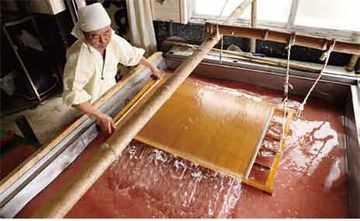지장
| 지장 Jijang (Korean Paper Making) |
|
 지장, 국가문화유산포털, 문화재청. |
|
| 대표명칭 | 지장 |
|---|---|
| 영문명칭 | Jijang (Korean Paper Making) |
| 한자 | 紙匠 |
| 주소 | 경기도 가평군 청평면 작은매골길70 |
| 지정(등록) 종목 | 경기도 무형문화재 제16호 |
| 지정(등록)일 | 1996년 12월 24일 |
| 분류 | 무형문화재/전통기술/공예 |
| 웹사이트 | 지장, 국가문화유산포털, 문화재청. |
해설문
국문
지장(紙匠)은 닥나무와 닥풀[황촉규(黃蜀葵)]을 주재료로 하여 전통한지를 제작하는 장인을 말한다. 우리의 전통한지는 두 장을 겹쳐서 한 장의 종이를 만들며, 중국의 걸러뜨기, 일본의 쌍발뜨기와 달리, 발이라는 도구를 이용하여 직접 뜨는 외발뜨기라는 방식을 사용한다. 신라시대부터 만들었던 한지는 고려시대에 중국 송나라에서 극찬받기도 하였다. 조선시대에는 각 분야의 장인중 지장의 수가 가장 많을 정도로 기반이 탄탄하였으나 일제강점기때 일본에서 서양종이를 대량 생산하는 방식을 들여온 후 지금은 일부에서만 명맥을 유지하고 있다.
고(故) 장용훈 선생은 전남 장성과 전북 임실에서 전통 방식으로 한지를 제조하다가 1977년 양질의 닥나무가 많고 물이 맑은 가평으로 이전하여 1996년 경기도 무형문화재 지장, 2010년 국가 중요 무형문화재 제117호 한지장으로 지정되었다. 2016년 선생이 타계하신 후에는 장남인 장성우 선생에게 전승되어 2019년 6월 10일 경기도 무형문화재 보유자로 인정받았다.
12~2월에 닥나무 1년생을 채취하여 찌기, 닥나무껍질 벗기기(백피), 잿물로 삶기, 세척 및 티고르기, 닥섬유 두드리기(고해), 닥풀섞기(해리), 종이뜨기, 물짜기, 건조를 거쳐 다듬이질(도침)을 통해 전통한지가 완성된다.
영문
Jijang (Korean Paper Making)
Jijang refers to the traditional craft* of making Korean traditional paper Hanji, as well as to the master artisans who make it.
Korean traditional paper is made from wood of one year-old mulberry tree harvested between December and February. After harvesting, it undergoes a strenuous process including the following steps: steaming, skinning the bark, boiling the bark in lye, washing and removing the remaining bark and soil particles, pounding the received bark fiber, mixing the fiber with mucus extracted from Abelmoschus manihot, forming sheet out of the mixture, squeezing moisture, and drying. What is particularly unique about the process of making Hanji is the use of a device called bal to form a single sheet of paper out of two. It is said that Hanji has been produced since the Silla period (57 BCE – 935 CE) and during the Goryeo period (918-1392), it was highly praised in Song China. Paper making remained well-established and widely practiced in Korea up until the end of the Joseon Period (1392-1910). During the Japanese colonial period (1910-1945), technologies for mass-production of paper were introduced in Korea, significantly shrinking the demand for Hanji, which currently continues to be made only in few places.
Jang Yong-hun (1937-2016) was a master of Korean traditional paper making and worked in the areas of Jangseong in Cheollanam-do and Imsil in Jeollabuk-do. In 1977 he moved to Gapyeong due to the abundance of mulberry trees with superb characteristics and clean water in the area. In 1996 and 2010, he was respectively designated as a holder of Intangible Cultural Heritage of Gyeonggi-do and National 중요(?)** Intangible Cultural Heritage. The technology of paper making used by Jang Yong-hun was passed on to his oldest son Jang Seong-u, who in 2019 was also recognized as a holder of Intangible Cultural Heritage of Gyeonggi-do.
- I guess “craft” is more appropriate than “art” in this case.
- Not sure how to translate this type of heritage.
영문 해설 내용
지장은 닥나무와 닥풀을 주재료로 하여 전통 한지를 제작하는 기술과 그 기술을 보유한 장인을 가리키는 말이다.
한국의 전통 한지는 12~2월에 닥나무 1년생을 채취하여 찌기, 닥나무껍질 벗기기, 잿물로 삶기, 세척 및 티고르기, 닥섬유 두드리기, 닥풀 섞기, 종이 뜨기, 물짜기, 건조를 거쳐 다듬이질을 하면 완성된다. 발이라는 도구를 사용하여 뜨는 방식으로 만들며, 두 장을 겹쳐서 한 장의 종이를 만든다는 점이 특징이다. 한지는 신라 때부터 만들었다고 전하며 고려 때에는 중국 송나라에서 극찬을 받기도 하였다. 조선시대에는 각 공예기술 분야의 장인 중 지장의 수가 가장 많을 정도로 기반이 탄탄하였으나, 일제강점기 때 종이를 대량 생산하는 방식이 도입된 후 지금은 일부에서만 명맥을 유지하고 있다.
장용훈(1937-2016)은 전남 장성과 전북 임실에서 전통 방식으로 한지를 제조하던 장인이다. 1977년 양질의 닥나무가 많고 물이 맑은 가평으로 이전하여 1996년 경기도 무형문화재, 2010년 국가중요무형문화재 한지장 보유자로 지정되었다. 2016년 장용훈이 세상을 떠난 후에는 장남인 장성우에게 한지 제작 기술이 전승되었고, 장성우는 2019년 경기도 무형문화재 보유자로 인정받았다.